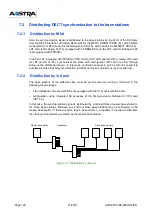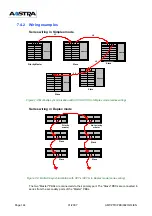
AMT/PTD/PBX/0020/2/4/EN
01/2007
Page 129
6.2.14synchronization
The set of FPS backplane allows the DECT clock to be sent on the loop and simplifies the DECT
synchronization wiring in a single-site configuration
The CSI board generates a DECT clock and sends this clock to all the PBX clusters. The
synchronization signal is sent via the loop and extracted by the RMH boards. The DECT
synchronization signal is then sent to the LDT boards via the back plane.
Hardware specifications
•
The PBX is equipped with a CSI card.
•
Only the LDT cards are used to connect base stations.
•
All clusters are equipped with RMH cards, ref.: HJ3773BD03 (minimum index for transmitting
the DECT clock on the loop) for sending the DECT clock.
•
The plugs used with the LDT cards are AVADQ plugs (ref HR5124B),
•
Jumpers TOPRAD correctly set on the FPS backplane
Configuration
•
The DECT base stations must be configured in synchronization mode by the M bit.
•
All the LDT cards must be configured as "Slaves" ("Master"/"Slave" mode can be configured
via jumper CA1.1).
•
For co-located clusters: there is no transmission delay on the loop. The setting is the same on
all the RMH cards, V=1. Therefore, the switches must be configured as follows (factory
configuration):
CA3-3 and CA3-4 = OFF
CA2 + CA1+ CA3-1,2 = ON
Binary value: ON = 0 ; OFF = 1
Figure 6-10: Default configuration (factory configuration) of switches CA1, CA2, CA3
on the RMH card (V= 1)
CA2
ON
1 2
4
3
CA1
ON
CA3
ON
1 2
4
3
RET10
RET0
NMULTI not used
(always OFF)
1 2
4
3
Summary of Contents for NeXspan C
Page 2: ...Page 2 01 2007 AMT PTD PBX 0020 2 4 EN...
Page 20: ...Page 20 01 2007 AMT PTD PBX 0020 2 4 EN...
Page 66: ...Page 66 01 2007 AMT PTD PBX 0020 2 4 EN...
Page 70: ...Page 70 01 2007 AMT PTD PBX 0020 2 4 EN Figure 4 2 Bottom view of the LD4 ST card...
Page 134: ...Page 134 01 2007 AMT PTD PBX 0020 2 4 EN...
















































